| SOUNDTRACK SCREENPLAY DOWNLOADS SCREENINGS DVD |  |
|
|
 |
 |
 |
 |
 |
 |
|
||||||
|
BUCHAREST - 4 November Dimitrie Gusti Back to Diary Index |
Walking out of the plane at Bucharest airport I am greeted by a familiar smell – not an unpleasant one – the smell I associate with Eastern Europe. Spices, cooked apple, autumn leaves, disinfectant,; the smell of marble halls, of overheated apartment blocks with parquet floors, of the plumbing in hotel rooms, the exhaust fumes from Ladas and Trabants, expensive perfume on fur coats and the wet hides of stray dogs. Shortly after the arrival at the hotel it is time to go to the Romanian TV station to record an interview, which will be 45 minutes long, a luxurious amount of time in television terms. The interviewer, Catalin Stefanescu, is well prepared and relaxed and we discuss, amongst other things, the music of Nicolae Gutsa (a gypsy musician apparently looked down on by Romanian intellectuals) whose voice I adore. In protest at the diminished stature of gypsy musicians I insist that both Gutsa and the Taraf de Haidouks, who I was blessed to work with on THE MAN WHO CRIED, are ‘national treasures’ who deserve to be honoured in their homeland. We then go to dinner with Codruta Cruceanu, our kind, modest host from the British Council who speaks an immaculate, literary English; Silvia Ciurescu, the producer of the show - an ex ballet dancer and responsible for screening “The Tango Lesson” on Romanian television - and Catalin. The dinner is in a restaurant on a side street and the building is guarded by security men. But once the doors open we are in a different world. The décor (elaborate), choice of performers (for there is a continuous floor-show) and menu is the work of an ample woman dressed in red with an elaborate hat who interrupts the proceedings regularly to make speeches with an echoing microphone. Many of the speeches refer to her ‘aristocratic’ and artistic roots, apparently, and merge with a kind of patriotic eulogy. My hosts for the evening are groaning with embarrassment but I am fascinated by everything. The musicians (one of the singers, a crooner, is also a high-ranking official in the ministry for cultural affairs, apparently), the dancers (national ballroom dance champions) and two women sitting at the next table who must be sisters and whose faces in profile could easily be found in nineteenth century paintings, particularly French. I want to take a photograph of them but discover that in my eagerness to try, one last time, for rational packing (one smallish bag only) I have left my camera at home. Christopher obliges me by photographing them at the end of the evening but, although they agree, they look suddenly stiff and depressed and I feel bad at objectifying them in this way and possibly ruining their evening. Or perhaps being praised for their beauty has suddenly brought unbidden feelings to the surface, longings and disappointments. The next day Codruta takes us for a walk around Bucharest’s historic quarter, crumbling, beautiful, slowly being butchered by development, and on the way she shows us how every wall has become a billboard site. Many huge advertisements are attached to apartment blocks, covering scores of windows. Apparently people can see out, just, through the mesh. In addition to the ravages of advertising there are also many of the familiar fashion chains (Benetton, Gap, etc) tormenting a mostly poor population with their goods. The new rich can afford their goodies, apparently, or the stores would not survive for long, but I saw few people in them. The overall impression of the city and its architecture was the evidence of a grand and varied past, with buildings that looked Viennese, Parisian, 30s art-nouveau, modernist, post-modernist, in varying states of disrepair but many with a haunting beauty, overgrown, tumbling down, and in the case of several small churches (now being restored) surrounded by new blocks, hidden from view. That night, after I have given an introductory few words to a packed house, we sit and watch both ORLANDO and THE MAN WHO CRIED, the first time I have seen them in years. It is a shocking experience. I feel curiously detached, as though someone else was responsible for them, and yet swimming in memories. I find myself admiring what works – I can suddenly see that ORLANDO really was a ground-breaking adaptation, very bold and cheeky in the liberties it takes with a literary classic, and yet somehow so true to the book’s irreverence. Alexei’s camerawork looks stunning. Tilda looks luminous. Sandy’s costumes are miraculous. And I can feel the physical energy it all took….the years of obstacles and rejections to overcome, the hours (28) I spent standing on the frozen sea as a day shoot merged into a night shoot and I refused to leave the set even for a few minutes for a break, fearful that I would miss something, lose the opportunity to find a camera position, to ‘see’ the potential of the light, the dark. With THE MAN WHO CRIED I see many errors of judgement; but if anyone knew the personal circumstances in which it was made they would think it my best film. The Q &A goes fine, although it is late at night. Afterwards, a shy young person approaches me, to ask me, as there are so many dogs and horses in the film, do I love animals? She is studying to be a vet. next |
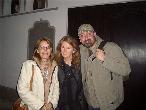 Silvia Ciurescu & Catalin Stefanescu 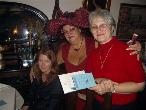 Red woman with Codruta Cruceanu 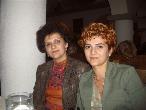 The two sisters 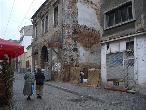 Historic quarter 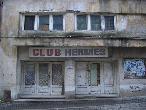 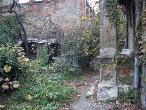 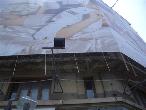 Billboards  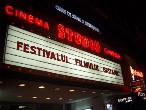 |
||||
Text © Sally Potter. All pictures © Adventure Pictures unless otherwise indicated |